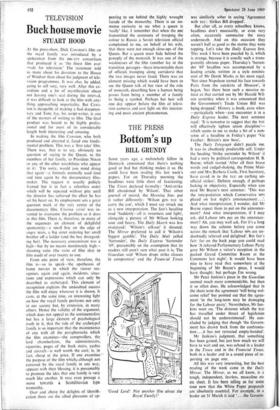Buck house movie
TELEVISION STUART HOOD
At the press-show, Dick Cawston's film on the royal family was introduced by a spokesman from the BBC-ITV consortium that produced it as 'the finest film ever made for television.' The statement told us more about his devotion to the House of Windsor than about his judgment of tele- vision programmes. It was also, he added, going to sell very, very well. After this ex- ordium and a lot of mystification about not leaving one's seat during the interval, it was difficult to look at the film with any- thing approaching impartiality. But Caws- ton is incapable of making a bad documen- tary and Tony Jay, his script-writer, is one of the masters of writing to film. The final product was bound to be highly profes- sional and for most of its considerable length both interesting and amusing.
In making the film Cawston, who both produced and directed it, faced one funda- mental problem. This was a 'first take' film. There was, that is to say, obviously no question of saying to the Queen, to the members of her family, to President Nixon or any of the other notabilities who appear in it: 'I'm sorry, would you mind doing that again'—a formula normally used time and time again by the documentary film- maker. The request is usually politely framed but is in fact a relentless order which will be repeated without pity until the director has achieved the effect he has set his heart on. Its employment sets a great question mark at the very centre of the documentary film. Cinema verite was in- vented to overcome the problem as it does in this film. There is, therefore, in many of the sequences an element of delightful spontaneity—a small boy on the edge of angry tears, a big sister ordering her small brother off a ladder (and the boy disregard- ing her). The necessary concomitant was a high—but by no means inordinately high— shooting ratio (the ratio of film shot to film used) of over twenty to one.
From one point of view, therefore, the film is—so to speak—the apotheosis of home movies in which the viewer rec- ognises, again and again, incidents, situa- tions and expressions which can only be described as archetypal. This element of recognition explains the undoubted success the film will enjoy wherever it is shown. It casts, at the same time, an interesting light on how the royal family performs not only in our society but, by extension, in many others. Hence the validity of the argument, which does not appeal to the sentimentalists but has a large element of psychological truth in it, that the role of the archetypal family is so important that the maintenance of one with all the paraphernalia which the film examines—the comptrollers, the lord chamberlains, the administrators, equerries, pages of the back stairs, yachts and aircraft—is well worth the cost; is, in fact, cheap at the price. If one examines the purpose of the film which, although not censored by the royal family in any way, appears with their blessing, it is presumably to promote the idea that one family is very much like another. It may, even presage a
identifi-
cation there are the allied pleasures of ap-
towards a Scandinavian type monarchy. Over and above the delights of identifi-
pearing
pearing to see behind the highly wrought facade of the monarchy. There is an im- mense curiosity to see what a queen is 'really' like. I remember that when the BBC transmitted the ceremony of trooping the colour to Russia a Soviet television official complained to me, on behalf of his wife, that there were not enough close-ups of the Queen. But a queen must hide behind the panoply of the monarch. It was one of the weaknesses of the film (another lay in the transition passages—those interminable shots of officials tramping along corridors) that the two images never fused. There was an element missing which would have been to see the Queen talk of her view of the role of monarch, describing how a human being passes from being a member of a family to being a symbol. Perhaps her heir will one day appear before the film of televi- sion cameras and cast light on this interest- ing and most ancient phenomenon.


































 Previous page
Previous page